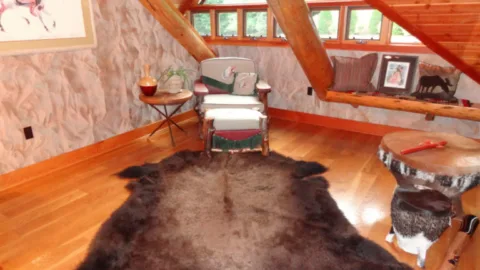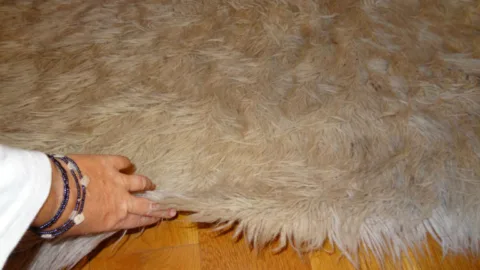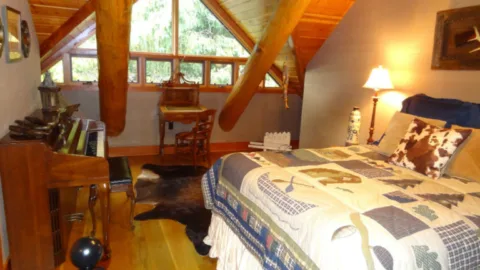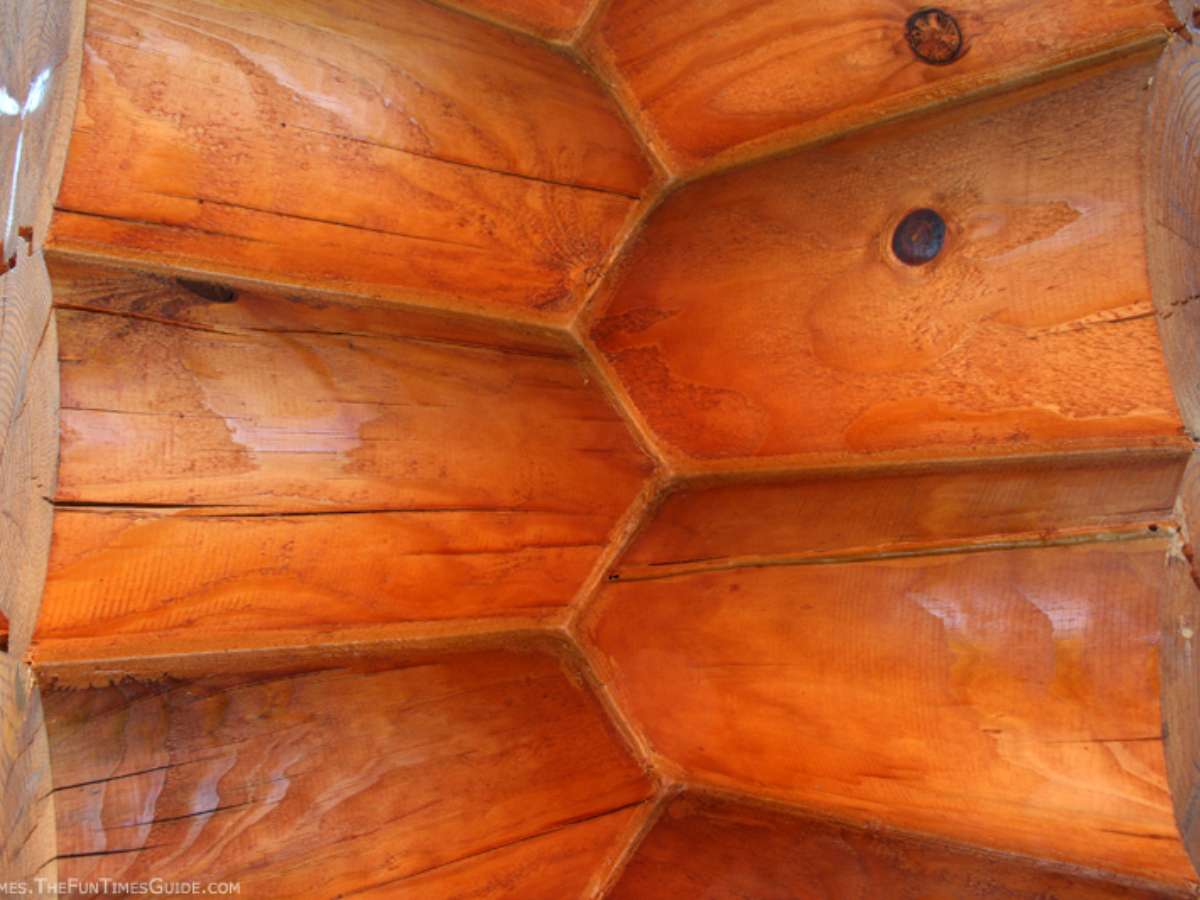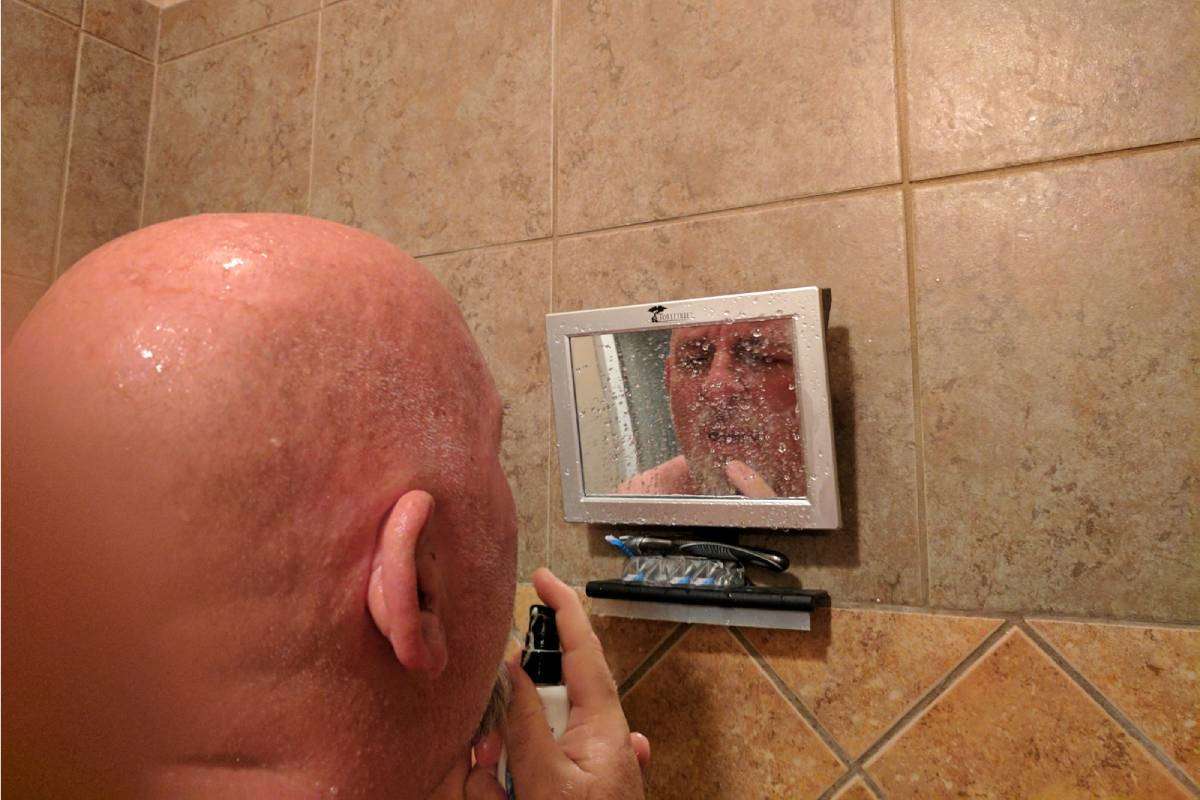If you have a log home, chances are you have at least one accent piece made of leather or animal hide.
And at some point, it will need cleaned (or at least freshened up a bit).
Here are some of the ways that leather rugs (cowhide rugs, animal skin rugs, etc.) can be used as a focal piece in your home decor:
- Cowhide and other leather rugs are often used to warm up cold floors — like stone, tile, and hardwood.
- Leather & hide are also used on upholstered furniture to create a warm and rustic cabin-like setting.
- Animal skin rugs and leather rugs are commonly draped on the backs of couches, chairs as decoration.
- Leather rugs and animal hides are often hung on walls to add warmth, texture, and color in an otherwise drab room.
Without a doubt, these beautiful and natural products add an authentic quality to the “cozy cabin” or “lodge-like” feel of a home.
However, it’s important that you know how to clean and repair your leather & hide rugs — so they’ll look good as new for years to come.
Leather rugs vary in type and style, and can be made from the skins of many different animals.
Some leather rugs have elaborate pressed designs, making them somewhat fancy. While others are truly rustic looking.
Most commonly available as hides, leather rugs are also made by stitching or weaving strips of leather and suede to create quilt-like designs. Another style consists of ribbons of leather constructed to mimic a shag-style rug. Source
Here’s what you need to know to care for your leather rugs…
Don’t Do This To Your Leather Rugs:
- Don’t display them in a place that gets lots of sun. Leather rugs do not fare well in direct sunlight. The heat and light will dry out the skin, causing it to crack or curl.
- Don’t put them on the floor in high traffic areas. Too much foot traffic across the skin may cause it to quickly wear thin.
- Don’t display them in damp or humid rooms. Too much moisture can cause mold to grow, in addition to weakening the structure of the leather.
Those types of damage to leather & cowhide rugs cannot be repaired. Here’s why:
- While curls can be trimmed off, the worn material doesn’t grow back.
- Sometimes cracks in the skin can be stitched closed and a leather treatment can be used to re-moisturize the skin, but it will never be the same.
- The longer an animal skin rug remains moist or damp, the more likely the leather is to stiffen and harden prematurely.
Do This To Care For Your Leather Rugs:
- Shake out leather & cowhide rugs instead of vacuuming them to remove loose dirt and dust. (Never use a beater bar on them!) Shaking out rugs gives them a chance to “breathe” some fresh air.
Leather rugs are relatively simple to keep clean and dust free. In fact, weekly cleaning is important so grit and debris deep within the pile do not scratch the leather and thus damage the rug. To keep leather rugs clean at home, it is best to shake them out on a regular basis. Dust particles and small fragments lodged within the pile can be removed by shaking out the rug, as the strands of leather are nicely spaced apart. Source
- Gently brush animal skin rugs in the direction of the grain (or the hair growth, if it’s a fur rug). If your leather rug has hair, lightly brush the leather with a wire rug brush designed for brushing fur (like a wire pet brush). If your leather rug does not have hair, use a suede brush instead. Try to remove as much dust, dirt, and grime as you can with the brush.
Shake unscented talcum powder on fur, sheepskin, and hair-on hide rugs and leave for several hours. Brush the talcum powder through the hair, then shake it out. Repeat this process several times, depending on the length of the fur. Source
- Mix 5% white vinegar and 95% water in a spray bottle. Working in small areas at a time, lightly spray the rug with the solution. Then wipe that area with a soft sponge. Dry the rug immediately with a clean, dry rag. This process will “freshen up” a leather rug that isn’t stained. (The vinegar helps balance the pH and neutralize odors. It also kills any bacteria.)
Many brands of organic shampoo are non-alkaline. A solution made of 95 percent water and 5 percent organic white vinegar is a suitable alternative to non-alkaline soap because it maintains the pH balance of the cowhide rug, which protects its fibers and coloring. It also helps to remove bad odors from the rug. Source
- To remove stains, use a leather cleaner. If possible, choose a leather cleaner that is specifically for use with your particular animal skin type.
Equal parts of vinegar and water will remove stains that spill on your leather rug. Small amounts of rubbing alcohol can be applied directly to the stain. With any solution that you use on your rug, rub the spot first and if still tough use a soft brush to renew the nap of the suede. Before applying any chemical or remedy, perform a spot test in any inconspicuous area to ensure compatibility with your leather rugs. Source
- Apply a leather conditioner if the rug is very hard and brittle. If possible, choose a leather conditioner that is specifically made for the type of animal skin rug you have.
Quality leather conditioners contain fats and/or oils that help to moisturize leather, keeping it supple, replenished, and lustrous. Do not use products that contain petroleum or mineral oils, as they are very drying and can damage leather over time. In general, look for products that contain quality natural oils, like mink oil. But don’t overdo it: leather conditioners are meant for occasional use. Source
- Waterproof and seal your leather rugs after they’ve been cleaned. Look for a top quality leather or suede protector.
Water is no friend to leather. When leather gets wet, water forms temporary bonds with the oils lubricating the leather’s fibers and floats them away. This leaves leather drier and stiffer. The protein bonds holding the leather fibers together become brittle and are more easily broken. Source
- Give your leather or cowhide rug plenty of time to air dry by draping it (evenly) over a banister or railing. Make sure your rugs have dried completely before placing them on your floor, furniture, or walls. Never use heat — like the sun or a hair dryer — to dry leather rugs.
If spot cleaning only, then air dry the affected area by placing books or other objects underneath that portion of the rug. Source
- Remove any curled edges by turning the hide fur-side down and then using a sharp knife to cut the underside of the rug at a 45-degree angle across the grain of the fur.
Curling is caused by your cowhide drying out and the skin is contracting This can be due to heat exposure like strong sun, heaters or under floor heating and normally happens over a long period of time … Cutting from the underside cuts the leather but not the hair leaving you a nice layer of hair falling over the edge. Source
- Fix any cracks or tears by turning the hide fur-side down over a wooden work surface, then using a sharp awl and a mallet to pierce small holes along the edges of any cracks or tears. Use a heavy upholstery thread and needle to sew across the tear with overcast stitches. (Your thread should be close in color to the hide — so it will blend in as much as possible.)
You may also want to sew a leather strip underneath the free edges of the rug. This is done to provide additional support that keeps the edges of the area rug from curling inward and provides protection against future wear and tear. Source
- Air your leather cowhide rugs out every few months by hanging them fur-side down over a banister or railing outside in the sun. Do this for no more than 1-2 hours at a time though; we’ve already talked about how too much sunlight can damage leather rugs. The idea is to give your rugs a healthy dose of fresh air after being cooped up inside gathering dust & dirt. A little bit of sunlight is good for rugs — it’s a natural disinfectant.
You can save time, electricity, chemical exposure, and wear and tear by putting the sun to work. It’s simple: Just put items that need freshening outside on a dry, sunny day. Give each item a good shake if you can, and hang it! Source
More About Displaying & Cleaning Leather Rugs
Here are some more helpful tips for your leather, animal skin & cowhide rugs:
- How To Mount & Hang A Rug On The Wall
- Cowhide Rug Care & Cleaning Tips
- How To Flatten A Curling Cowhide Rug
- Are Leather Rugs A Good Idea Or Not?
- How To Wash & Brush A Natural Sheepskin Rug
- The Benefits Of Animal Skin Rugs
- How To Clean & Care For Sheepskin
- Can You Wash (And Iron) A Cowhide Rug?
- Before You Put Rugs On Hardwood Floors…
- How To Turn A Rug Into Wall Art
Just For Fun…
Here’s a video showing how to make a leather belt rug.

